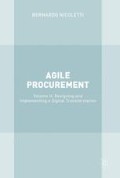Abstract
This chapter analyzes the channels which allow procurement to communicate with customers, both internal to the organization or end customers.
The chapter analyzes the new channels in detail, considering mobility and its applications in the procurement process. It then analyzes cloud computing and the innovative ways in which the cloud can be used to communicate and interact with the customers of the procurement. For each of these channels, the chapter analyzes the components and the potential applications. It also highlights the pros and cons of each. In the case of cloud computing, the chapter presents an innovative business case considering all the costs and benefits of this solution.
Access this chapter
Tax calculation will be finalised at checkout
Purchases are for personal use only
Notes
- 1.
Mirsch, T., Lehrer, C., and Jung, R. (2016). Transitioning to an Omnichannel Approach: A Dynamic Capability Perspective. http://aisel.aisnet.org/icis2016/ISStrategy/Presentations/20/, Accessed 7 January 2017.
- 2.
Martin, C.J. (2016). The sharing economy: A pathway to sustainability or a nightmarish form of neoliberal capitalism? Ecological Economics, 121: 149–159.
- 3.
Taniar, D. (Ed.). (2008). Data mining and knowledge discovery technologies. IGI Global, Hershey, PA.
- 4.
Giessmann et al., (2012) Mobile Enterprise Applications—Current State and Future Directions. In System Science (HICSS)., IEEE Proceedings of the 2012 45th Hawaii International Conference: 1363–1372.
- 5.
Dospinescu et al. (2008). Mobile enterprise resource planning: new technology horizons. Communications of the IBIMA.
- 6.
Dospinescu et al. (2008). Mobile enterprise resource planning: new technology horizons. Communications of the IBIMA.
- 7.
Sabraz Nawaz, S., Pulasinghe, K., and Thelijjagoda, S. (2015). Mobile office and its implications for ERP systems: a review of literature, International Journal of Advanced Research in Computer Science and Software Engineering, 5(5), May: 12–16.
- 8.
https://www.forrester.com/report/2013+Mobile+Workforce+Adoption+Trends/-/E-RES89442, Accessed 18 November 2016.
- 9.
http://www.gartner.com/newsroom/id/3404817, Accessed 12 August 2017.
- 10.
Gebauer, J., Shaw, M.J., and Zhao, K. (2003). The efficacy of mobile e-Procurement: A pilot study. In System Sciences.
- 11.
Nicoletti, B. (2012), Lean and Digitize: An Integrated Approach to Process Improvement. Gower Publishing, Farnham, UK.
- 12.
Gebauer, J., Shaw, M.J., and Zhao, K. (2003). The efficacy of mobile e-Procurement: A pilot study. In System Sciences.
- 13.
- 14.
Stackpole, B. (2016), Tech Forecast 2017: 5 key technologies to double down on now, http://www.cio.com/article/3150006/emerging-technology/tech-forecast-2017-5-key-technologies-to-double-down-on-now.html?upd=1484169089879, Accessed 11 January 2017.
- 15.
Mell, P., and Grance, T. (2011). The NIST definition of cloud computing, NIST White Paper.
- 16.
Nicoletti, B. (2010). Cloud computing in financial services, Palgrave, London, UK.
- 17.
https://www.cloudpeople.it/author/alex56/page/18/, Accessed 21 October 2016.
- 18.
http://www.reply.it/it/practices/selective-outsourcing-application-management/readr/,11960, Accessed 22 November 2016.
- 19.
https://aws.amazon.com/solutions/case-studies/imperia-monferrina/?nc1=h_ls, Accessed 12 April 2017.
- 20.
Liu, F., Tong, J., Mao, J., Bohn, R., Messina, J., Badger, L., and Leaf, D. (2011). NIST cloud computing reference architecture. NIST special publication, 500: 292.
- 21.
Kruger, C.P., and Hancke, G.P. (2014, July). Implementing the Internet of Things vision in industrial wireless sensor networks. In 2014 12th IEEE International Conference on Industrial Informatics (INDIN): 627–632.
- 22.
Zincir, O., Ünal, A., and Erdal, M. (2017). Lean and Digital: A Case Study on Procurement and Supply Chain Professionals’ Online Social Network. In Key Challenges and Opportunities in Web Entrepreneurship. IGI Global, Hershey, PA: 79–102.
- 23.
Ackermann, T., Widjaja, T., Benlian, A., and Buxmann, P. (2012). Perceived IT security risks of cloud computing: conceptualization and scale development. http://aisel.aisnet.org/icis2012/proceedings/ISSecurity/3/, Accessed 20 April 2017.
- 24.
Nicoletti, B. (2016), Critical Success Factors in the Total Cost Management of Cloud Computing, Management Account, Sept–Oct.
- 25.
Tetteh, A., and Xu, Q. (2014). Supply Chain Distribution Networks: Single-, Dual-, & Omni-Channel. Interdiscipl J Res Bus, 3(9): 63–73.
Author information
Authors and Affiliations
Rights and permissions
Copyright information
© 2018 The Author(s)
About this chapter
Cite this chapter
Nicoletti, B. (2018). Channels in Agile Procurement. In: Agile Procurement . Palgrave Macmillan, Cham. https://doi.org/10.1007/978-3-319-61085-6_4
Download citation
DOI: https://doi.org/10.1007/978-3-319-61085-6_4
Published:
Publisher Name: Palgrave Macmillan, Cham
Print ISBN: 978-3-319-61084-9
Online ISBN: 978-3-319-61085-6
eBook Packages: Business and ManagementBusiness and Management (R0)

